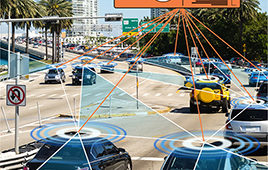First-Ever Simultaneous GPS Survey in 50 States Will Benefit Nation’s Mapping Capability
March 18, 2011

Geodesists continuously measure points on the Earth’s surface because there are several different types of motion that occurs. By using GPS, geodesists can monitor the movement of a site 24 hours a day, seven days a week.
Download here (Credit: NOAA)
Hundreds of surveyors from all around the United States will join NOAA’s National Geodetic Survey on Saturday, March 19, at exactly 1 p.m. EDT, in the first-ever Surveying USA Day, a kick-off event commemorating Surveyor’s Week coordinated by the National Society of Professional Surveyors.
The event will provide professional, government and independent surveyors the opportunity to collect global positioning system (GPS) data simultaneously from various different methods, including handheld GPS devices, as well as more sophisticated surveying equipment.
As a result, NOAA is expecting a large influx of data submitted to its Online Positioning User Service (OPUS)—a new database tool that allows surveyors, engineers, and other users to share their survey results.
OPUS serves as a direct conduit to the NOAA’s National Spatial Reference System (NSRS), the coordinate system maintained by NOAA that defines latitude, longitude, height, scale, gravity, and orientation throughout the United States. The system is designed to meet our nation’s economic, social, and environmental needs. The NSRS provides the foundation for mapping and charting; state boundaries; transportation, communication, and land-records systems; and numerous scientific and engineering applications and provides more than $2.4 billion in estimated annual benefits to the U.S. economy.
“Our nation was built on the foundational work of surveyors. Every piece of infrastructure –from roads to buildings, airports, levees and pipelines– needs accurate positioning data,” said Juliana Blackwell, director of NOAA’s National Geodetic Survey. “The work of geographers, cartographers and engineers all rely on having accurate positional data provided by surveyors. We are eager to see the amounts and types of survey data we receive on Saturday.”
For over 200 years, NGS and its predecessor agencies have collaborated with public and private organizations to establish reference stations at precisely-determined locations. Traditionally, these locations have been identified by setting a survey mark, usually a brass, bronze or aluminum disk. Locations might also be identified by a deep-driven rod or a prominent object, such as a water tower or church spire. This collection of more than 1,500,000 points—plus more than 1,650 Continuously Operating Reference Stations that provide GPS data—are coordinated and monitored by NGS to form the NSRS.
NOAA’s mission is to understand and predict changes in the Earth’s environment, from the depths of the ocean to the surface of the sun, and to conserve and manage our coastal and marine resources. Find us on Facebook.




